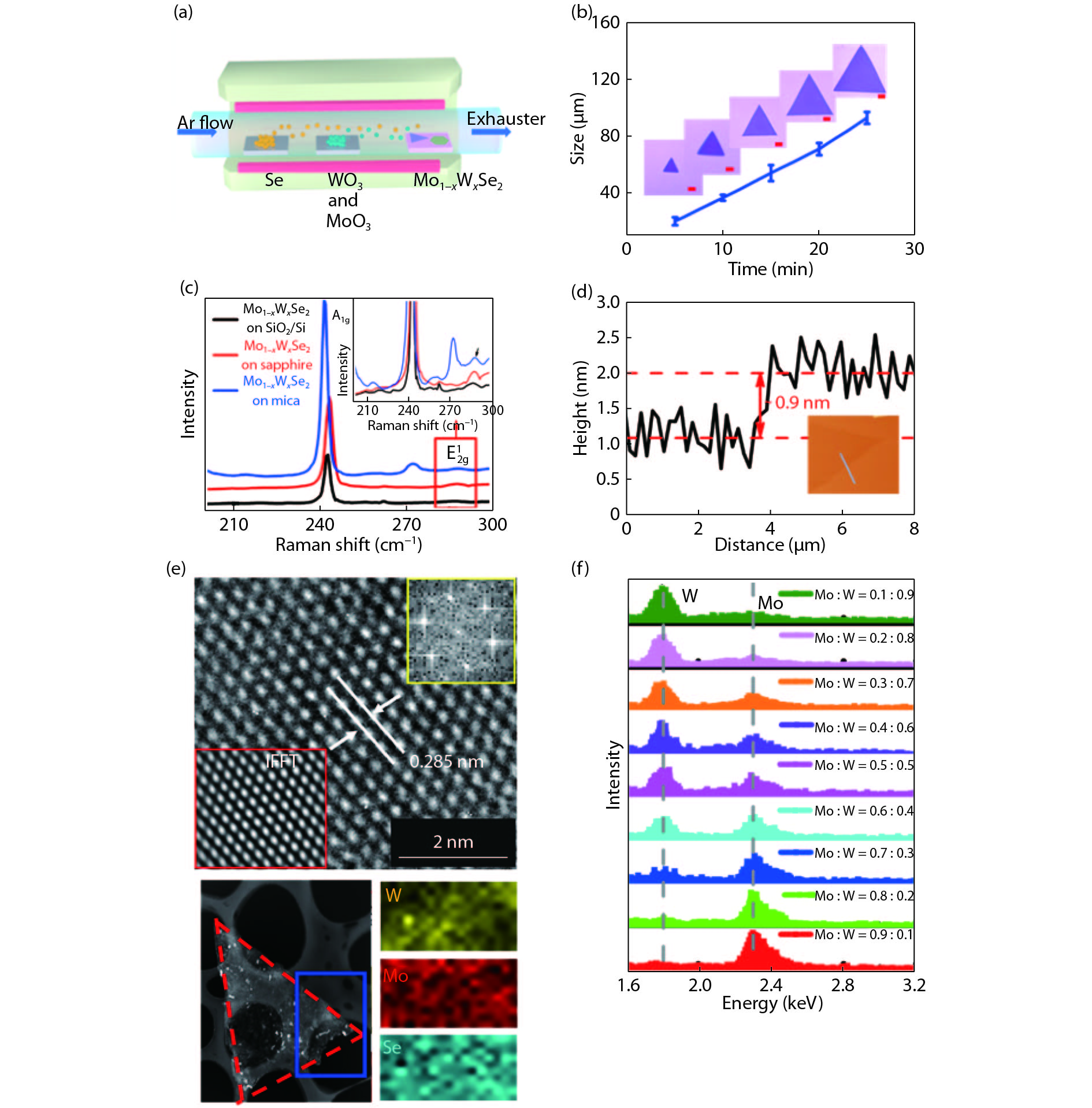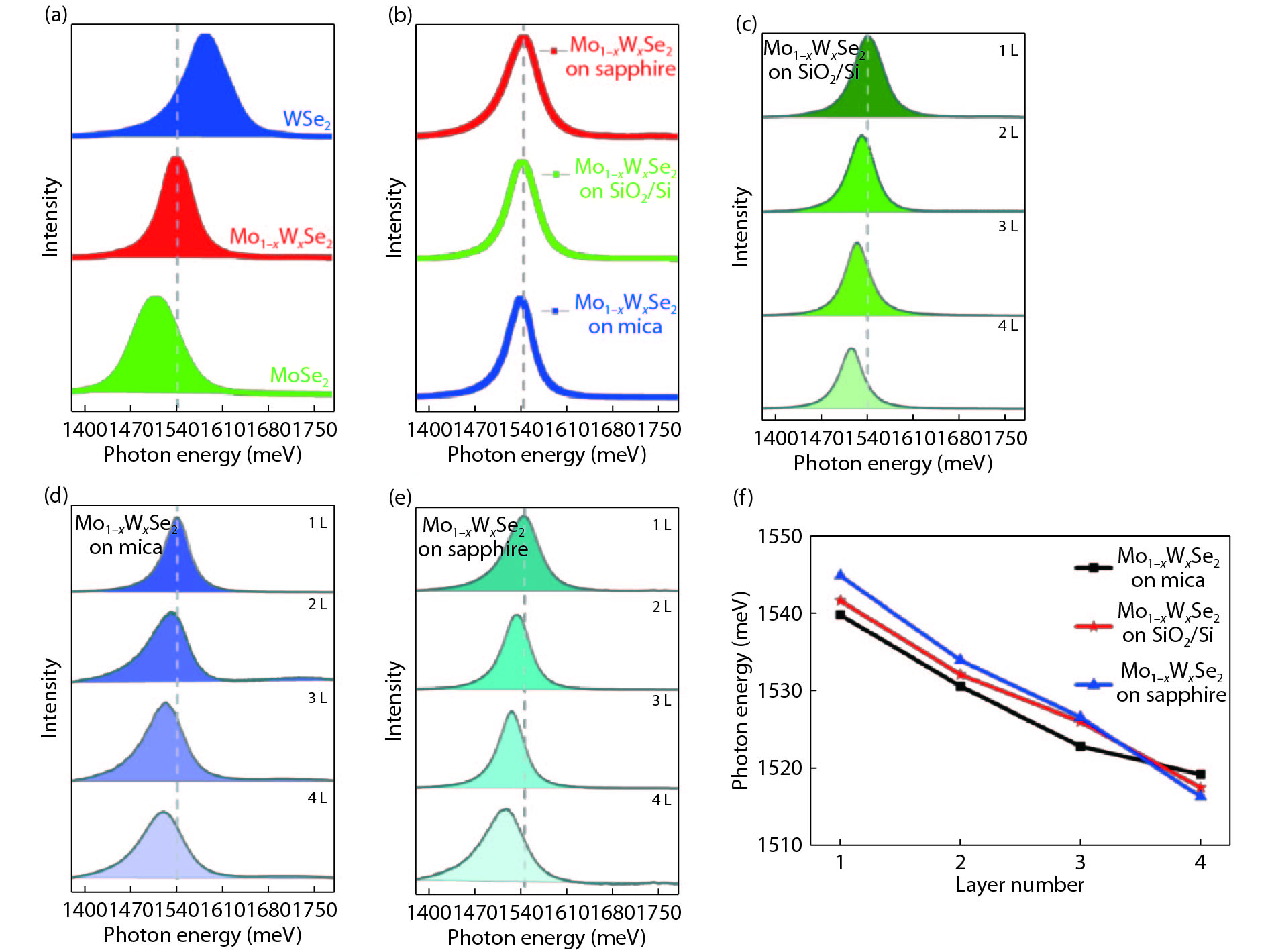| Citation: |
Fang Liang, Hejun Xu, Zuoyuan Dong, Yafeng Xie, Chen Luo, Yin Xia, Jian Zhang, Jun Wang, Xing Wu. Substrates and interlayer coupling effects on Mo1−xWxSe2 alloys[J]. Journal of Semiconductors, 2019, 40(6): 062005. doi: 10.1088/1674-4926/40/6/062005
****
F Liang, H J Xu, Z Y Dong, Y F Xie, C Luo, Y Xia, J Zhang, J Wang, X Wu, Substrates and interlayer coupling effects on Mo1−xWxSe2 alloys[J]. J. Semicond., 2019, 40(6): 062005. doi: 10.1088/1674-4926/40/6/062005.
|
Substrates and interlayer coupling effects on Mo1−xWxSe2 alloys
DOI: 10.1088/1674-4926/40/6/062005
More Information
-
Abstract
Two-dimensional (2D) transition metal dichalcogenides alloys are potential materials in the application of photodetectors over a wide spectral range due to their composition-dependent bandgaps. The study of bandgap engineering is important for the application of 2D materials in devices. Here, we grow the Mo1−xWxSe2 alloys on mica, sapphire and SiO2/Si substrates by chemical vapor deposition (CVD) method. Mo1−xWxSe2 alloys are grown on the mica substrates by CVD method for the first time. Photoluminescence (PL) spectroscopy is used to investigate the effects of substrates and interlayer coupling force on the optical bandgaps of as-grown Mo1−xWxSe2 alloys. We find that the substrates used in this work have an ignorable effect on the optical bandgaps of as-grown Mo1−xWxSe2. The interlayer coupling effect on the optical bandgaps of as-grown Mo1−xWxSe2 is larger than the substrates effect. These findings provide a new way for the future study of the growth and physical properties of 2D alloy materials.-
Keywords:
- Mo1−xWxSe2,
- substrates,
- two-dimensional materials,
- bandgaps,
- photoluminescence
-
References
[1] Zhang G, Huang S, Chaves A, et al. Infrared fingerprints of few-layer black phosphorus. Nat Commun, 2017, 8, 14071 doi: 10.1038/ncomms14071[2] Mogi M, Kawamura M, Yoshimi R, et al. A magnetic heterostructure of topological insulators as a candidate for an axion insulator. Nat Mater, 2017, 16(5), 516 doi: 10.1038/nmat4855[3] Zhang Y, Chang T R, Zhou B, et al. Direct observation of the transition from indirect to direct bandgap in atomically thin epitaxial MoSe2. Nat Nanotechnol, 2014, 9(2), 111 doi: 10.1038/nnano.2013.277[4] Bertolazzi S, Gobbi M, Zhao Y, et al. Molecular chemistry approaches for tuning the properties of two-dimensional transition metal dichalcogenides. Chem Soc Rev, 2018, 47(17), 6845 doi: 10.1039/C8CS00169C[5] Manimunda P, Nakanishi Y, Jaques Y M, et al. Nanoscale deformation and friction characteristics of atomically thin WSe2 and heterostructure using nanoscratch and Raman spectroscopy. 2D Mater, 2017, 4(4), 045005 doi: 10.1088/2053-1583/aa8475[6] Wang C, Wu X, Ma Y, et al. Metallic few-layered VSe2 nanosheets: high two-dimensional conductivity for flexible in-plane solid-state supercapacitors. J Mater Chem A, 2018, 6(18), 8299 doi: 10.1039/C8TA00089A[7] Xiao S, Xiao P, Zhang X, et al. Atomic-layer soft plasma etching of MoS2. Sci Rep, 2016, 6, 19945 doi: 10.1038/srep19945[8] Zhang X, Nan H, Xiao S, et al. Shape-uniform, high-quality monolayered MoS2 crystals for gate-tunable photoluminescence. ACS Appl Mater Inter, 2017, 9(48), 42121 doi: 10.1021/acsami.7b14189[9] Novoselov K S, Geim A K, Morozov S V, et al. Electric field effect in atomically thin carbon flims. Science, 2004, 306(5686), 666 doi: 10.1126/science.1102896[10] Zheng Z, Yao J, Yang G. Centimeter-scale deposition of Mo0.5W0.5Se2 alloy film for high-performance photodetectors on versatile substrates. ACS Appl Mater Inter, 2017, 9(17), 14920 doi: 10.1021/acsami.7b02166[11] Liu J, Zhong M, Liu X, et al. Two-dimensional plumbum-doped tin diselenide monolayer transistor with high on/off ratio. Nanotech, 2018, 29(47), 474002 doi: 10.1088/1361-6528/aadf5a[12] Zhou W, Zou X, Najmaei S, et al. Intrinsic structural defects in monolayer molybdenum disulfide. Nano Lett, 2013, 13(6), 2615 doi: 10.1021/nl4007479[13] Yao J, Zheng Z, Yang G. Promoting the performance of layered-material photodetectors by alloy engineering. ACS Appl Mater Inte, 2016, 8(20), 12915 doi: 10.1021/acsami.6b03691[14] Lu C P, Li G, Mao J, et al. Bandgap, mid-gap states, and gating effects in MoS2. Nano Lett, 2014, 14(8), 4628 doi: 10.1021/nl501659n[15] Kang J, Tongay S, Li J, et al. Monolayer semiconducting transition metal dichalcogenide alloys: Stability and band bowing. J Appl Phys, 2013, 113(14), 143703 doi: 10.1063/1.4799126[16] Peng Q, De S. Tunable band gaps of mono-layer hexagonal BNC heterostructures. Physica E, 2012, 44(7/8), 1662 doi: 10.1016/j.physe.2012.04.011[17] Ye J, Niu B, Li Y, et al. Exciton valley dynamics in monolayer Mo1− xWxSe2 (x = 0, 0.5, 1). Appl Phys Lett, 2017, 111(15), 152106 doi: 10.1063/1.4995517[18] Zhang C, Kc S, Nie Y, et al. Charge mediated reversible metal−insulator transition in monolayer MoTe2 and W xMo1− xTe2 alloy. ACS Nano, 2016, 10(8), 7370 doi: 10.1021/acsnano.6b00148[19] Livneh T, Dumcenco D O, Pinkas I. Determining alloy composition in Mo xW(1− x)S2 from low wavenumber Raman spectroscopy. J Raman Spectrosc, 2017, 48(5), 773 doi: 10.1002/jrs.v48.5[20] Li H, Zhang Q, Duan X, et al. Lateral growth of composition graded atomic layer MoS(2(1− x))Se(2 x) nanosheets. J Am Chem Soc, 2015, 137(16), 5284 doi: 10.1021/jacs.5b01594[21] Liu J, Liu X, Chen Z, et al. Tunable Schottky barrier width and enormously enhanced photoresponsivity in Sb doped SnS2 monolayer. Nano Res, 2018, 12(2), 463 doi: 10.1007/s12274-018-2243-1[22] Li H, Duan X, Wu X, et al. Growth of alloy MoS(2 x)Se2(1− x) nanosheets with fully tunable chemical compositions and optical properties. J Am Chem Soc, 2014, 136(10), 3756 doi: 10.1021/ja500069b[23] Duan X, Wang C, Fan Z, et al. Synthesis of WS2xSe2−2 x alloy nanosheets with composition-tunable electronic properties. Nano Lett, 2016, 16(1), 264 doi: 10.1021/acs.nanolett.5b03662 [24] Chen Y, Dumcenco D O, Zhu Y, et al. Composition-dependent Raman modes of Mo(1− x)W( x)S2 monolayer alloys. Nanoscale, 2014, 6(5), 2833 doi: 10.1039/C3NR05630A[25] Dumcenco D O, Kobayashi H , Liu Z, et al. Visualization and quantification of transition metal atomic mixing in Mo1− xWxSe2 single layers. Nat Commun, 2013, 4, 1351 doi: 10.1038/ncomms2351[26] Song J G, Ryu G H, Lee S J, et al. Controllable synthesis of molybdenum tungsten disulfide alloy for vertically composition-controlled multilayer. Nat Commun, 2015, 6, 7817 doi: 10.1038/ncomms8817[27] Dumcenco D O, Chen K Y, Wang Y P, et al. Raman study of 2H-Mo1− xWxS2 layered mixed crystals. J Alloy Compd, 2010, 506(2), 940 doi: 10.1016/j.jallcom.2010.07.120[28] Zhang X, Xiao S, Shi L, et al. Large-size Mo1− xWxS2 and Mo1− xWxS2 (x = 0−0.5) monolayers by confined-space chemical vapor deposition. Appl Surf Sci, 2018, 457, 591 doi: 10.1016/j.apsusc.2018.06.299[29] Ke T Y, Hsu H P, Wang Y P, et al. Temperature dependent piezoreflectance study of Mo1− xWxSe2 layered crystals. J Appl Phys, 2015, 118(21), 215704 doi: 10.1063/1.4936621[30] Yarali M, Brahmi H, Yan Z, et al. Effect of metal doping and vacancies on the thermal conductivity of monolayer molybdenum diselenide. ACS Appl Mater Inter, 2018, 10(5), 4921 doi: 10.1021/acsami.7b14310[31] Xu H, Wu X, Li X, et al. Properties of graphene-metal contacts probed by Raman spectroscopy. Carbon, 2018, 127, 491 doi: 10.1016/j.carbon.2017.11.035[32] Liang F, Xu H, Wu X, et al. Raman spectroscopy characterization of two-dimensional materials. Chin Phys B, 2018, 27(3), 037802 doi: 10.1088/1674-1056/27/3/037802[33] Luo C, Wang C, Wu X, et al. In situ transmission electron microscopy characterization and manipulation of two-dimensional layered materials beyond graphene. Small, 2017, 13(35), 1604259 doi: 10.1002/smll.v13.35[34] Xia J, Huang X, Liu L Z, et al. CVD synthesis of large-area, highly crystalline MoSe2 atomic layers on diverse substrates and application to photodetectors. Nanoscale, 2014, 6(15), 8949 doi: 10.1039/C4NR02311K[35] Huang J, Yang L, Liu D, et al. Large-area synthesis of monolayer WSe2 on a SiO2/Si substrate and its device applications. Nanoscale, 2015, 7(9), 4193 doi: 10.1039/C4NR07045C -
Proportional views






 DownLoad:
DownLoad:

















